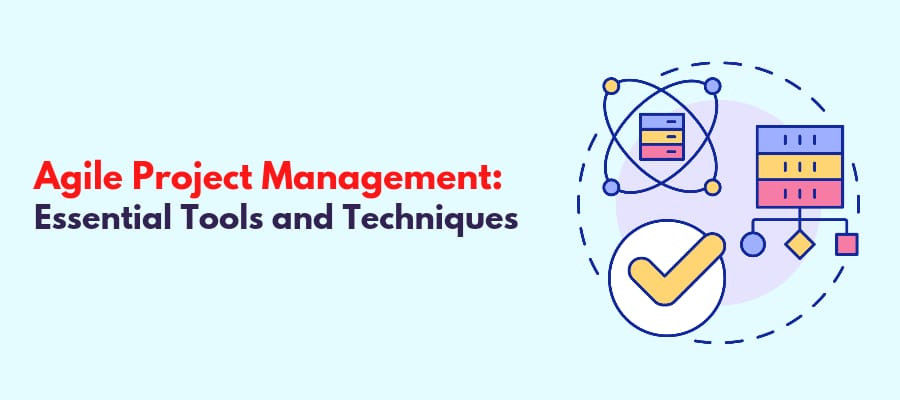Agile Project Management: Essential Tools and Techniques

The principles of agile project management, which centre on teamwork and adaptability, are at the cutting edge of the project management revolution. As a result, it has become the method of choice for many businesses that see the need for a more malleable and adaptable project management method.
Delivering projects that satisfy client objectives is at the heart of the agile approach to project management, which also provides a framework for ongoing process improvement. Agile project management relies on teamwork, adaptability, and a focus on constant development. Key techniques and tools for managing agile projects are:
Top 5 Agile Project Management Tools
1. ClickUp
ClickUp is a powerful cloud-based project management system designed to meet the needs of any size or type of business. It offers a comprehensive suite of tools and features to manage projects, assign tasks, and collaborate in a highly visible way. The intuitive design and customization capabilities make ClickUp incredibly easy and flexible, enabling businesses to work with agile methodologies. The numerous themes, colours, and drag-and-drop features allow users to customize their workspace to their specifications. The primary goal of ClickUp is to significantly boost employee productivity.
2. Jira
Jira has been the top choice for issue-tracking solutions in the IT industry for more than two decades. Developed by Atlassian, Jira has evolved and extended its functionalities to support agile methodologies. Its advanced capabilities are useful for development teams and other departments such as HR, sales, and marketing. HR managers can streamline their internal workflows and facilitate the hiring process by utilizing Jira. Sales personnel can use it to track customer journeys and develop effective selling strategies.
3. Teamwork
Teamwork is a web development and intranet service provider which has grown with the advent of team collaboration systems. Its key feature is adaptable project management solutions designed to cater to small groups. It offers in-built messaging, version control, file sharing, time tracking, task management, and project budgeting. It also has capacity management that helps to keep track of the resources needed cost-effectively. Teamwork's user-friendly UI makes it a great choice for small businesses, just like how Jira's UI is suitable for larger companies. It helps to ensure that projects are completed on time, efficiently and without overspending.
4. Wrike
Wrike is the perfect tool for effective project management. It's an ideal way to centralize and connect multiple projects while increasing your team's efficiency. The interface may be useful, but setting up tasks is simple and easy. Wrike is always up to date with their releases and enhancements, though the mobile versions may lag behind the desktop versions in updating. This may be frustrating if you're expecting to see changes on your mobile device simultaneously as they happen on your desktop.
5. Asana
Asana is the go-to cloud-based project and task management software for tracking, planning, and organizing all your team's tasks - from start to finish. With Asana, you'll get the features you need to set up projects and tasks, monitor progress, and communicate with your team. It's perfect for Agile project management, as Asana makes it easy to track launches and iterations and plan, manage, and communicate sprints.
Top 5 Techniques
1. Kanban
Kanban is widely used in the Agile community to manage projects. The word "visual signal" originates from Japanese, and the concept often involves using visual boards to monitor schedules and milestones. Its visual depiction of tasks' development has replaced spreadsheets as the go-to way for monitoring project development. Tasks and processes may be identified and prioritized with greater ease.
2. Scrum
Scrum is a popular Agile methodology used to manage complex projects, and it's based on the principles of self-organization, collaboration, and continuous improvement. It is often used when there is a need to adapt quickly to changing customer or business requirements. Scrum is based on specific roles, ceremonies, and artifacts.
3. Crystal Methodology
The Crystal Methodology is an Agile project management approach that focuses on delivering high-quality projects and customer satisfaction. The core principles of the Crystal Methodology are flexibility, adaptability, communication, and learning. It is based on the idea that successful projects require the right mix of people, processes, and tools.
4. Extreme Programming
When it comes to software development, Extreme Programming (XP) is the approach of choice because of its emphasis on constant feedback and incremental progress. This is an iterative process where the client provides constant input to ensure the code is doing what it should. Modifying the code in tiny, incremental steps is at the heart of XP.
5. DSDM Methodology
The DSDM Methodology is an Agile project management approach for managing projects to reduce the time required to complete them while increasing their quality. Timeboxing, teamwork, and incremental improvement are the cornerstones of this Methodology. Timeboxing is a method used in Agile that allows a certain amount of time to complete a specific job.
Conclusion
Businesses increasingly favour agile project management because of its greater adaptability and flexibility. You can use the methods and resources discussed below to finish projects on schedule and within budget. Among the most well-known project management applications are ClickUp, Jira, Teamwork, Wrike, and Asana. Successful project management may be achieved by applying the five Agile techniques: Kanban, Scrum, Crystal Methodology, Extreme Programming, and DSDM Methodology. Companies may benefit from Agile project management if it is implemented with the proper tools and methodologies.
Reference
- https://www.proofhub.com/articles/agile-project-management-tools-list
- https://squeezegrowth.com/agile-project-management-tools-and-techniques/#Agile_Project_Management_Techniques_You_Should_Know
- https://www.actitime.com/project-management/project-management-tools-and-techniques



